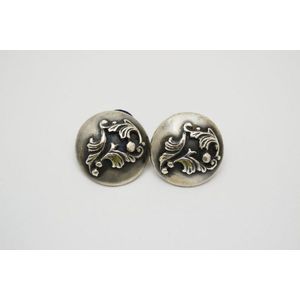Georgian Sterling Silver Wine Ewer, London 1787
You must be a subscriber, and be logged in to view price and dealer details.
Subscribe Now to view actual auction price for this item
When you subscribe, you have the option of setting the currency in which to display prices to $Au, $US, $NZ or Stg.
- Ewer / Pitcher - A type of jug with a narrow neck bulbous body and wide spout, originally used for carrying and storing liquids such as water or wine. In medieval times they were the source of water to wash ones hands during and after a meal. later the shape was used for vessels in silver, gold, glass and ceramics.
In Victorian times they were made in ceramics and occasionally glass with a matching basin, and sometimes other accessories such as a soap holder or toothbrush holder. Their purpose was to provide facilities for personal washing In the early 19th century were often enclosed in purpose built stands, and later resided on a washstand..
Sometimes the words "ewer" and "pitcher" are used interchangably, but a pitcher is generally considered to be a jug, and would have a wide mouth, and a gently tapering body. - Neo Classical - The period or style, known as "neo-classical", was based on Greek and Roman designs and motifs, and is usually associated with the influence of the four Adam brothers, but principally Robert Adam, the second oldest of the brothers, who were architects and designers, active in the latter half ot the 18th century (1760s to 1790s).
Born in Scotland in 1728, Robert Adam spent time in Italy studying and his designs are influenced by the finds made during the excavation of Pompei.
When he returned to England he became the Court Architect to George III (1738-1820).
In turn, designs by Adam then influenced Hepplewhite.
Neo-classical ornamentation is characterised by use of classical urns, palmettes, mythical creatures such as the sphinx and griffin, ram's heads, swags, scrolling foliage, and use of the Greek key pattern. - George Iii - George III (1738 - 1820) was King of Great Britain and Ireland from 1760 to 1820.
- Hallmarks - A mark stamped on articles of precious metals in Britain, since the 14th century, certifying their purity. It derives its name from the Guild Hall of the Goldsmiths' Company, who recieved its Charter in 1327 giving it the power to assay (test the purity) and mark articles of gold and silver.
The hallmark will consist of several marks, including the:
- silver standard mark, indicating the purity of the metal. Sterling silver is .925 pure silver.
- the city mark indicating the city in which it was assayed eg London, Birmingham, York etc.
- the date mark, usually a letter of the alphabet in a particular font and case,
- a duty mark, indicating whether duty had been paid to the crown, and only in use from 1784 to 1890
The piece may include an additional mark, the maker's mark, although not forming part of the hallmark, will be located in the vicinity of the hallmarks.
Sometimes silver plated items will bear faux hallmarks, often confusing those not familiar with silver markings. - Sterling Silver - Sterling silver is a mixture of 92.5% pure silver and 7.5% of another metal, usually copper. Fine silver is 99.9% pure silver, and is relatively soft and the addition of the very small amount of copper gives the metal enough strength and hardness to be worked into jewellery, decorative and household objects.
- Finial - An architectural decoration, found on the upper parts of of an object. On furniture they are usually found on pediments, canopies and shelf supports. On smaller ceramic or silver items, such as spoons, they may decorate the top of the item itself, or the lid or cover where they provide a useful handle for removal.
Finials have a variety of shapes and forms. They may be urn-shaped, baluster shaped round or spiral, but usually taper into an upper point. Many real life shapes may also be used as finials, such as pineapples, berries, pinecones, buds, lotus and acorns. Sometimes animals such as a lion are depicted, or fish and dolphins.
This item has been included into following indexes:
Visually similar items

A Tibetan bronze counter-flowing kettle and pouch, the kettle embossed with a seated Buddhist monk on both sides reserved against a profusely decorated field of Indian lotus, the spout issuing from a demon's mouth, the handle in the shape of a arching lion

Large Meiji period (1868-1912), Japanese bronze model of an elephant, naturalistically cast striding forward with trunk raised, wood stand, signed 'GenryUSAi Seiya'. Length 52 cm

An emerald ring by Sandy Kilpatrick, centrally set with an emerald cut en cabochon in 18ct gold, circa 1990, ring size J, signed 'S'. Exhibitions: Sandy Kilpatrick's work was exhibited in the contemporary jewellery Gallery, Sydney, 5 July 1989. Other Notes

Two silver Art Nouveau buttons. Unmarked (2)
